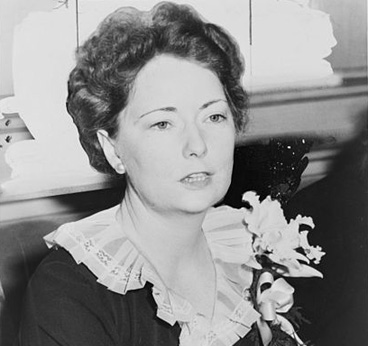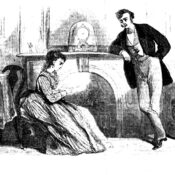For years, Margaret Mitchell worked at an Atlanta newspaper by day and, by night, worked on her novel. She showed it to only one publisher, who immediately recognized a work of great talent. When “Gone With The Wind” appeared, 75 years ago this month, it won the Pulitzer Prize and was an immediate best-seller. Since then, over 30 million copies have been sold, and it has become America’s best loved novel (according to a 2008 Harris poll.)
Despite such a resounding success, Margaret Mitchell, like that other great Southern novelist, Harper Lee, published only one novel. She must have heard endless pleas for a sequel, or another novel. But she steadfastly refused— or did she?
In 1940, the Post reported it had received
a flat brown envelope, with the name of a famous publishing house written in the corner. In the envelope was a letter and a fifty-page manuscript. The letter, typewritten on the stationery of a Park Avenue hotel, said:
Undoubtedly you have heard of, or possibly read my book “Gone With The Wind.” I have since created the direct opposite of my heroine “Scarlett O’Hara.” Dolore Day, the star of my new book “The Sun Broke Through,” is as kind and unselfish as Scarlett was spoiled and self-centered.
I should be extremely grateful if you would introduce… this special condensation of my book which I have enclosed.
I am leaving immediately, for a vacation and shall have the book published upon my return. You have my full authority to use this material without any further instruction from me.
Sincerely,
Margaret Mitchell
The Editor, taking a deep breath, then turned to the first page of the manuscript and read:
I advise you, also, to take a deep breath before you try reading the following two (only two) sentences.
THE SUN BROKE THROUGH
Exhausted, with broken spirit and heavy heart, fifteen year old Dolore Day, who had already at her age experienced the hardships and sufferings of a depressed world, walked home slowly after a difficult day at school, where she was none too ready to answer the confusing questions hurled at her by her instructors, concerning the day’s lessons, for Dolore’s mind was a million miles away in a beautiful haven where she and her family would be forever safe from the miseries of the slums. A place where her dear Dad would not have to get up at five on a cold winter morning, in spite of his cronical cough which was his souvenir of the war, and his everlasting backaches, to make steam so that his family and the family above him would not feel the piercing winds through the cracks of their two-story frame house where Lawrence Day, Dolore’s forty-year old father, froze all day in the cold Barber Shop beneath the apartment, to feed and meagerly clothe his six children all of whom were younger than Dolore.
The Editor picked up the phone, called the real Margaret Mitchell in Atlanta, and told her someone was using her name in vain. The would-be Mitchell never contacted the Post to get back her work.
The story would have ended there but the Post learned that this “Margaret Mitchell” was a woman of multiple ambitions. Shortly after this item ran, the editors received a note from the Bronx Home News, along with a letter:
“Despite the many stories we read of modern Cinderellas, the fact still remains that unless one is born wealthy or famous, there is very little if any chance for success.
“Recently I wrote a book entitled “The Sun Shines Through,” and sent it to David O. Selznick, of Hollywood. I know very well that an eighteen-year-old girl with no previous literary credit to her name would find it difficult to have a book published, or even read, so I signed the name of Margaret Mitchell. I also sent a carbon copy of the book to The Curtis Publishing Company.”
Something makes me wonder if the author was, indeed, eighteen years old.
The signature was “Debbie De Lane”; the address, a dental firm in the Bronx.
Debbie De Lane. . . . Something about those syllables sent a Home News reporter to the files. He came back with another letter, rebutting an editorial comment on a young woman who had applied for the post of official executioner of the state of New York:
“Have people the right to call me heartless just because I had the courage to apply for such a job? Would they condemn doctors who wield the knife on them to save their lives? Then why should they condemn a girl who is willing to punish criminals to save innocent people from future fears and troubles? If there were nobody willing to administer the punishment to offenders, none of us would be safe.”
The signature was “Betty La Salle”; the address, the same dental firm.
We have no knowledge, of course, why Miss La Salle’s application was rejected, but at least one reason suggests itself to us: There was official fear that, in place of the electric chair, she might be tempted to substitute readings from The Sun Shines Through.
I’ve been trying to come up a concluding remark to this story, but it’s just too…
Become a Saturday Evening Post member and enjoy unlimited access. Subscribe now




Comments
Always there is somebody who could write a sequel to GETW. Talent is ubiquitous. But it hasn’t Been done successfully. But it could. And would be greatly successful. We’re waiting.
Margaret Mitchell obviously was a stubborn woman who had no need for more fame or money. And likely didn’t enjoy writing. So she said: finis. Years she took writing her novel. And years more for a sequel.. ideals she had little.
“The Pen is Mightier than the Sword”….
outrageous to think that anyone could surpass Ms. Mitchell’s way with words!
Too much to think about today.
I’ll think about it tomorrow……..
I have a book called “Lost Laysen” that was published in 1996 and released by Debra Freer and was supposed to have been written by Margaret Mitchell and given to HenryAngel and then to his son, Henry Angel, Jr. He left them for years and also love letters to his father from her and he came across them after they were stored for years. Many pictures in the book are of her and Henry Angel and I have no clue if the info is correct.
“Gone with the Wind” was the one book
Margaret Mitchell wrote and had
Published. She never undertook
Any sequel which some thought sad.
What happened to Scarlett and Rhett?
Would their love be gone with the wind?
Was there hope for happiness yet,
Found perhaps in a sequel’s end?
But Mitchell flat out said no deal,
Refused until her dying day.
Some drunk driver was at the wheel
And Mitchell just got in his way.
The end is often tragedy,
And no sequel will ever be.
late in the day. And frankly, I don’t give a damn.